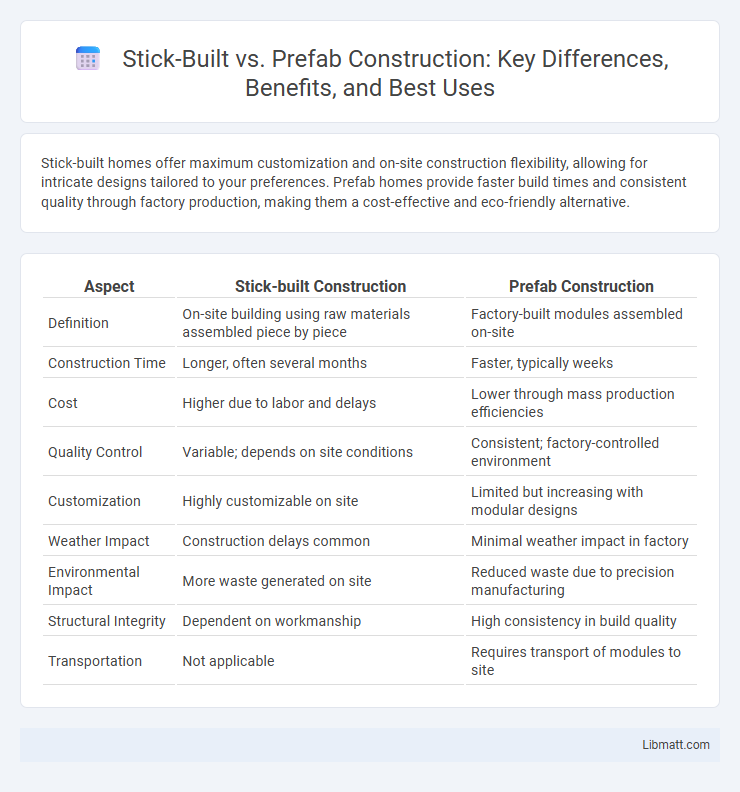Stick-built homes offer maximum customization and on-site construction flexibility, allowing for intricate designs tailored to your preferences. Prefab homes provide faster build times and consistent quality through factory production, making them a cost-effective and eco-friendly alternative.
Table of Comparison
| Aspect | Stick-built Construction | Prefab Construction |
|---|---|---|
| Definition | On-site building using raw materials assembled piece by piece | Factory-built modules assembled on-site |
| Construction Time | Longer, often several months | Faster, typically weeks |
| Cost | Higher due to labor and delays | Lower through mass production efficiencies |
| Quality Control | Variable; depends on site conditions | Consistent; factory-controlled environment |
| Customization | Highly customizable on site | Limited but increasing with modular designs |
| Weather Impact | Construction delays common | Minimal weather impact in factory |
| Environmental Impact | More waste generated on site | Reduced waste due to precision manufacturing |
| Structural Integrity | Dependent on workmanship | High consistency in build quality |
| Transportation | Not applicable | Requires transport of modules to site |
Introduction to Stick-Built and Prefab Construction
Stick-built construction involves assembling building components on-site using raw materials, allowing for customization and flexibility in design. Prefabricated (prefab) construction entails manufacturing sections or modules in a controlled factory environment before transporting them to the site for assembly, significantly reducing construction time. Both methods offer distinct advantages depending on project scope, budget, and timeline requirements.
What is Stick-Built Construction?
Stick-built construction refers to the traditional building method where a structure is constructed entirely on-site using individual pieces of lumber, such as studs, joists, and rafters. This approach allows for custom modifications throughout the building process and offers greater flexibility in design compared to prefab methods. Construction timelines are generally longer due to weather dependencies and the need for skilled labor during framing, insulation, and finishing stages.
What is Prefab Construction?
Prefab construction involves manufacturing building components off-site in a controlled factory environment before transporting them to the construction site for assembly. This method ensures consistent quality, reduces construction time, and minimizes waste compared to traditional stick-built techniques. Your project can benefit from prefab construction's efficiency, cost-effectiveness, and streamlined process.
Key Differences Between Stick-Built and Prefab
Stick-built homes are constructed entirely on-site using individual lumber pieces, allowing for greater customization and adaptability to specific design preferences. Prefab homes, including modular and panelized options, are manufactured in controlled factory environments, ensuring faster construction times and consistent quality through precision engineering. Key differences include construction speed, cost efficiency, environmental impact, and overall design flexibility, with prefab homes offering reduced waste and quicker installation while stick-built homes provide more on-site customization.
Cost Comparison: Stick-Built vs Prefab
Stick-built homes typically incur higher labor costs due to on-site construction which can extend timelines and increase expenses, whereas prefab homes benefit from factory-controlled settings that reduce labor time and waste. Material costs for prefab homes are often lower because of bulk purchasing and streamlined production processes, making them a more budget-friendly option. Understanding these differences helps you make an informed decision based on your cost priorities and project timelines.
Speed of Construction: Which is Faster?
Prefab homes significantly reduce construction time by up to 50% compared to stick-built homes due to factory-controlled environments and simultaneous site preparation. Stick-built construction often faces delays from weather conditions, material availability, and on-site labor coordination. Faster assembly of prefab components on-site accelerates overall project completion, making prefab the superior choice for speed of construction.
Quality and Durability Considerations
Stick-built homes offer customization and traditional craftsmanship, allowing for high-quality materials tailored to your specifications, but construction quality can vary based on local labor skills. Prefabricated homes utilize factory-controlled environments that ensure consistent build standards and reduced exposure to weather-related damage during assembly, often enhancing durability. Evaluating these factors helps determine the best balance of quality and longevity for your construction project.
Environmental Impact and Sustainability
Prefab homes generate less construction waste and consume fewer raw materials compared to stick-built homes, significantly reducing environmental impact. Factory-controlled settings allow for improved energy efficiency during construction, minimizing resource use and greenhouse gas emissions. Sustainable practices in prefab manufacturing contribute to lower carbon footprints and promote better utilization of renewable materials.
Customization and Design Flexibility
Stick-built homes offer unparalleled customization and design flexibility, allowing you to tailor every architectural detail to your preferences. Prefab homes provide streamlined construction but often come with predefined floor plans and limited modifications. Choosing stick-built construction empowers greater control over unique design elements to perfectly match your vision.
Choosing the Right Method for Your Project
Choosing the right construction method for your project depends on factors such as budget, timeline, and site conditions. Stick-built homes offer customization and adaptability on-site, while prefab options provide faster assembly and consistent quality through factory production. Evaluating your project's specific needs ensures you select a method that balances cost efficiency, design flexibility, and construction speed.
Stick-built vs prefab Infographic

 libmatt.com
libmatt.com